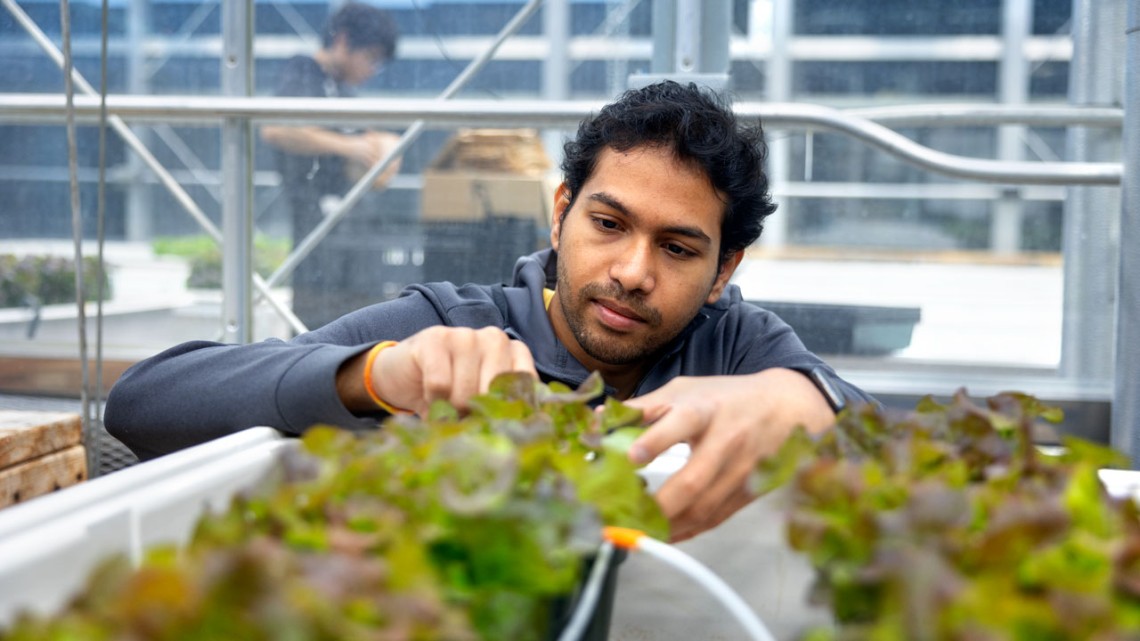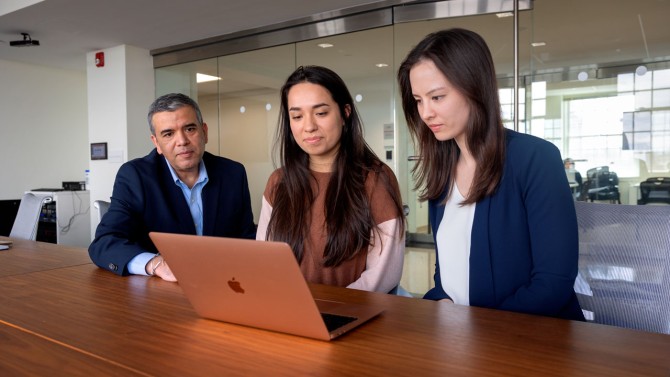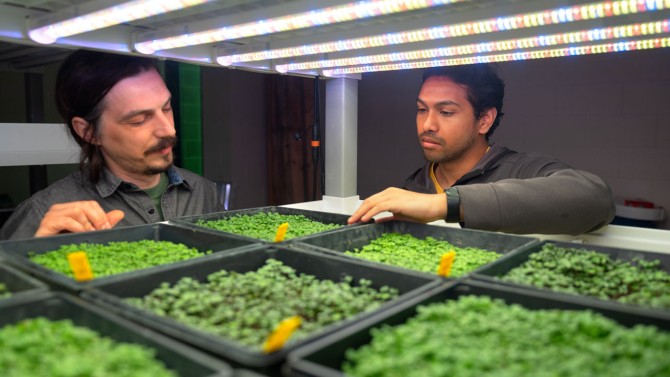
Cornell systems engineering doctoral student Akshay Ajagekar assesses the growth of lettuce plants in a Guterman Lab greenhouse. Ajagekar has prototyped an AI-based controller to reduce energy use in lettuce greenhouses in the state by 30%. New York has approved more than $400 million in public and private funding to create Empire AI, a consortium of seven of New York's leading universities and research institutions.
As Empire AI dawns, Cornell lays groundwork for public good
By Laura Reiley, Cornell Chronicle
Nutrition in the West is a young discipline – only 100 years old. Artificial intelligence is even newer. Combining the two could create a powerful tool to customize health advice, instead of the current one-size-fits-all approach.
“We can harness the power of AI to now personalize nutrition recommendations efficiently to a single person or group of people accounting for their biology, and importantly, we can also contextualize the advice for the food environment they live in,” said Dr. Saurabh Mehta, the Janet and Gordon Lankton Professor in the Division of Nutritional Sciences in the College of Human Ecology.
Mehta’s team is using generative AI to help power health dashboards and chatbots that use clinical information and data only from high-quality, evidence-based sources. It’s among dozens of ambitious, cross-disciplinary projects at Cornell that will be advanced by Empire AI, a $400 million effort to create a shared academic research computing facility. The users of that facility – including Cornell faculty and students – will aim to promote responsible research and AI opportunities focused on public good.
Announced April 22 by Gov. Kathy Hochul, the consortium comprises seven of New York’s leading universities and research institutions, including Cornell.
“Research that creates and uses AI is already changing the world, and researchers at Cornell are leading the way in responsible and trustworthy development of AI tools for the greatest good,” said Krystyn Van Vliet, vice president for research and innovation.
“We are so appreciative of the state and other contributors – Empire AI is a critical investment in a shared academic research computing facility that will impact fields ranging from agriculture to medicine and urban development,” she said. “The consortium of Cornell and other terrific New York state universities and research institutions partnered in a new way to imagine this, and now get to make it a reality.”
“Foundational research on generative AI requires immense computing power currently unavailable to academics,” said Kavita Bala, dean of Cornell Ann S. Bowers College of Computing and Information Science and lead dean of the Cornell AI Initiative. “Empire AI will change that, enabling core research in generative AI models in academia that can be applied for the benefit of society in areas as wide ranging as nutrition, climate change, material discovery, health and medicine, physics and more.”
Cornell researchers have laid the groundwork, already piloting research efforts to employ AI to benefit New Yorkers’ daily lives and health outcomes. Mehta – founding director of the Cornell Center for Precision Nutrition and Health (CPNH) – and Samantha Huey, a research associate in CPNH, are harnessing AI for a number of applications to help people make nutrition and health-related decisions for end users. This means consumers, but also those in governmental and nongovernmental agencies focused on effectively and efficiently establishing and following policy.
Mehta predicts that AI will accelerate the implementation of other nutrition and food-is-medicine programs, including medically tailored meals and grocery prescriptions.
“AI should impact the uptake and reach of Dietary Guidelines for Americans and help in defining policies and quantifying subsidies,” said Mehta, who is partnering with the Department of Nutrition and Food Safety at the World Health Organization (CPNH hosts the WHO collaborating center for nutrition research for health at Cornell) and Fei Wang, professor of population health sciences at Weill Cornell Medicine, among others, on this work. CPNH also is home to the Artificial Intelligence and Precision Nutrition Training Program, the first National Institutes of Health-supported training grant focused on AI.
The founding Empire AI institutions – also including Columbia University, New York University, Rensselaer Polytechnic Institute, the State University of New York, the City University of New York and the Flatiron Institute – will use funds to advance research through computational methods, including data analysis, theory, modeling and simulation.
Funding of this sort, said Greg Morrisett, the Jack and Rilla Neafsey Dean and Vice Provost of Cornell Tech, enables Cornell and other institutions to work with larger models than any university can afford on its own.
“Right now, the U.S. is the leading supplier of AI models,” he said. “But if we want to keep up with other countries, and with states like California and Massachusetts, these kinds of state-level investments are critical for supporting the research.”
At Cornell, artificial intelligence models are being harnessed in many other medical contexts.
Rachit Saluja, a doctoral student affiliated with the Department of Radiology at Weill Cornell Medicine, is employing this new technology to codify and systematize the language radiologists use to describe the images they read – advancements aimed at reducing workload for doctors and streamlining patient care. Saluja works with Mert Sabuncu, professor at Cornell Tech and in Cornell Engineering and vice chair of AI and engineering research in the Department of Radiology at Weill Cornell Medicine. Right now, Saluja and his team are collecting multi-modality datasets and figuring out how the model will ingest it all, aiming to create a system that suggests text.
There’s a lot of unstructured text data in radiologists’ reports, with little common nomenclature to describe what they see in images, Saluja said. “This text data is really valuable, and no AI could parse it until now. When there is an image present in the system, the model will look at the image and give recommendations to the radiologists.”
In order not to bias radiologists, he said, the AI model can give several recommendations for text.
“In the U.S., radiologists are clogged with workload,” Saluja said. “If we can develop clever workflows, they will be more efficient and make better decisions. The goal is not to replace the radiologists.”
Saluja said the research is about a year and a half from implementation, depending on resourcing, and that these AI models could be developed separately for the different areas of radiology – musculoskeletal, neuroradiology, mammography, etc. – or developed as a generalist model that can be fine-tuned for specific uses.
For patients, greater medical efficiency means shorter wait times and perhaps even keener diagnoses. For shoppers, increased food production efficiencies can mean more money in their pocket. Cornell systems engineering doctoral student Akshay Ajagekar has prototyped an AI-based controller to reduce energy use in lettuce greenhouses in the state by 30%, an innovation with the potential to reduce retail produce prices for New York shoppers.
A marked rise in controlled environment agriculture (CEA) and vertical farms in and around cities holds the promise of greater food security and resiliency. Its downside: Food grown indoors, often with robotics, banks of LED lights and computer-monitored watering and nutrient systems, comes with energy costs higher than food grown more traditionally with soil and sun.
“Can we apply AI where controllers can run by themselves in order to improve performance? I got intrigued by this problem and started investigating how to minimize overall energy consumption of greenhouses while maximizing production,” Ajagekar said.
He says they chose lettuce as a crop because it is grown in New York extensively, but tomatoes or other greenhouse crops could have been easily substituted. They conducted their trials in a greenhouse in Ithaca and a five-greenhouse system in New York City, using AI to minimize energy consumption by controlling indoor temperature, relative humidity, supplementary lighting and other variables.
“Both of these projects demonstrate efficiency quite nicely,” Ajagekar said. “This could be scalable in a cost-effective manner.”
At the moment, generative AI is often cast as a shape-shifting villain, sparking fears about loss of control, job displacement, perpetuating biases or disinformation, and chipping away at individual privacy. Public anxiety about this powerful tool has been exacerbated by the secrecy of generative AI companies intent on preserving their intellectual property.
Empire AI as a consortium and research computing facility will bring greater transparency to the promise and scope of this new technology, situating New York state at the epicenter of research aimed at improving lives.
“One of the ways mankind has overcome adversity in history is by embracing advances in technology,” Mehta said. “AI is here to stay and can make a difference in primary health care and for nutrition for people who need it the most.”
Media Contact
Get Cornell news delivered right to your inbox.
Subscribe



